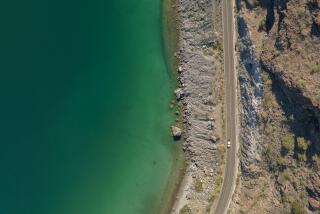A taste of the ‘real’ Puerto Rico
- Share via
Reporting from Isabela, Puerto Rico — Nobody seems to notice as the sun descends toward the shimmering sea. Children frolic along the beach as their parents sit nearby, chatting and playing cards. An old man snores contently in a hammock. Young couples embrace in the shelter of a shallow lagoon as the waves crash against a rocky reef. The aromas of garlic, onion and pepper waft across the strand, signaling that dinner preparations are underway at a beachfront restaurant.
The day is ending, but no one wants to let go of the daylight pleasures that draw people to Villas del Mar Hau, a smattering of pastel-colored beachside cottages just outside the town of Isabela, a few miles east of Aguadilla on Puerto Rico’s northern coast.
Planning your trip
Dozens of properties in Puerto Rico call themselves “paradores,” but fewer than two dozen so far have met the standards of the Puerto Rico Tourist Co., a branch of the Puerto Rican government. Information on them can be found by calling the tourism company at (800) 866-7827 or going to https://www.seepuertorico.com/paradores.
U.S. citizens do not need passports to visit Puerto Rico.
Most of the guests are city folk, seeking respite from their work and worries in San Juan, a couple of hours farther east. Within minutes of arriving, as complimentary cocktails are delivered to a villa’s patio, visitors realize they’ve found an escape far different from that at the endless, high-rise resorts that dot the Puerto Rican coastline. Villas del Mar Hau is one of Puerto Rico’s paradores, small, family-run inns that invite visitors to experience what owner Mirna Hau calls “the true Puerto Rico.”
The paradores — fewer than two dozen officially designated lodgings are scattered across the island — are modeled after the Spanish system of small, welcoming hotels. The Puerto Rican collection began about 35 years ago. “It was started to decentralize tourism from the metropolitan [San Juan] area,” Hau said. “We are a mirror of the Puerto Rico of today.”
Paradores are two- or three-star properties with ample and clean accommodations, often starting at a little more than $100 a night, but they don’t have the amenities and services of their well-known, upscale resort cousins. Each has a bar and restaurant featuring Puerto Rican specialties.
At Villas del Mar Hau, Mirna’s son, Herman, manages the open-air restaurant. In true Latin tradition, dinner is served well after the sun has set and the last hangers-on have left the lagoon. Over a meal of plantain soup, shrimp risotto and fresh red snapper in garlic sauce, each course more delicious than the previous, Mirna Hau shared how the villas’ roots extend back to her father’s acquisition of the land in 1958.
“He built a small cottage for our family,” she said. “There was no road, and you could only come in here by boat or by Jeep.
“[Friends] found out about our little cottage right in front of this paradise and they started to come by. Every single weekend, we had people coming over to visit and stay. It got to the point where we could not take any more people, so my father started building more cottages.”
It’s that “family welcoming family” attitude that permeates the paradores. Each is as individual as its owners, yet each provides a true island getaway unlike that which cruise ship passengers discover in San Juan.
The island’s mountainous interior offers solitude in a climate far different from that along the sea. It’s common to see afternoon temperatures in the 70s at Villas Sotomayor.
Set on the outskirts of Adjuntas in central Puerto Rico at an altitude of 2,765 feet, the parador consists of 17 cottages spread across 13 verdant acres, with cloud-draped mountains creating a moody backdrop. Nearby, waterfalls plunge into streams and pools. Some of the best sites are accessible only by mountain trails, so Villas Sotomayor has its own stable of 22 horses for use by guests.
In the lively but small bar, conversations are frequently interrupted by the screech of the lobby’s resident macaw. Don’t expect drinks made with world-famous Bacardi. Here, they serve DonQ, the preferred rum of locals.
Most of the paradores rely solely on the Internet for advertising.
The tourism company “puts too much emphasis on the big hotels,” said Miguel Rosalo, owner of Bahía Salinas, a charming, eight-room parador overlooking the Caribbean near Cabo Rojo on Puerto Rico’s southwestern coast.
But here, he said, “You can taste the real Puerto Rico.”
More to Read
Sign up for The Wild
We’ll help you find the best places to hike, bike and run, as well as the perfect silent spots for meditation and yoga.
You may occasionally receive promotional content from the Los Angeles Times.






